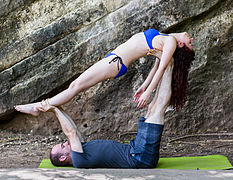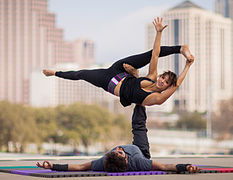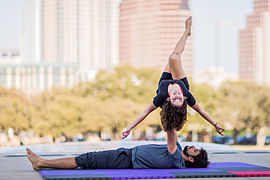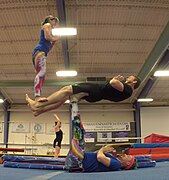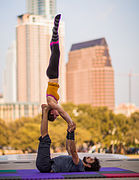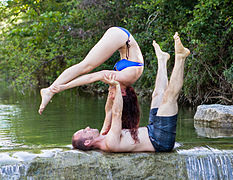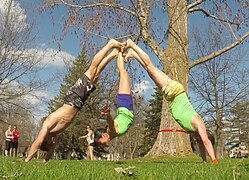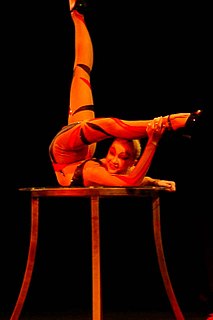
Contortion is a performance art in which performers called contortionists showcase their skills of extreme physical flexibility. Contortion acts often accompany acrobatics, circus acts, street performers and other live performing arts. Contortion acts are typically performed in front of a live audience. An act will showcase one or more artists performing a choreographed set of moves or poses, often to music, which require extreme flexibility. The physical flexibility required to perform such acts greatly exceeds that of the general population. It is the dramatic feats of seemingly inhuman flexibility that captivate audiences.
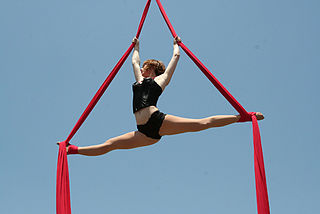
Acrobatics is the performance of human feats of balance, agility, and motor coordination. Acrobatic skills are used in performing arts, sporting events, and martial arts. Extensive use of acrobatic skills are most often performed in acro dance, circus, and gymnastics, and to a lesser extent in other athletic activities including ballet, slacklining and diving. Although acrobatics is most commonly associated with human body performance, the term is used to describe other types of performance, such as aerobatics.
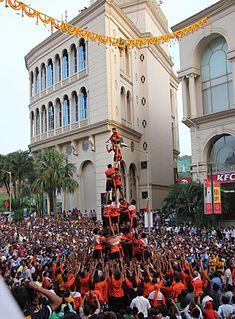
A human pyramid is an acrobatic formation of three or more people in which two or more people support a tier of higher people, who in turn may support other, higher tiers of people. People above the bottom tier may kneel or stand on the shoulders, backs or thighs of the people below them. Typically, the number of people in each tier is one greater than the tier immediately above it, resulting in a triangular structure reminiscent of the formation's namesake.

Acrobalance is a floor-based acrobatic art that involves balances, lifts and creating shapes performed in pairs or groups. A performer on the ground doing the lifting and supporting in an acrobalance formation is often called the base, while a performer being lifted or tossed can be referred to as the flyer. Formats include male/female duo, trio, female/female, and other variations.

Acro dance is a style of dance that combines classical dance technique with precision acrobatic elements. It is defined by its athletic character, its unique choreography, which seamlessly blends dance and acrobatics, and its use of acrobatics in a dance context. It is a popular dance style in amateur competitive dance as well as in professional dance theater and in contemporary circus productions such as those by Cirque du Soleil. This is in contrast to acrobatic, artistic and rhythmic gymnastics, which are sports that employ dance elements in a gymnastics context under the auspices of a governing gymnastics organization and subject to a Code of Points. Acro dance is known by various other names including acrobatic dance and gymnastic dance, though it is most commonly referred to simply as acro by dancers and dance professionals.
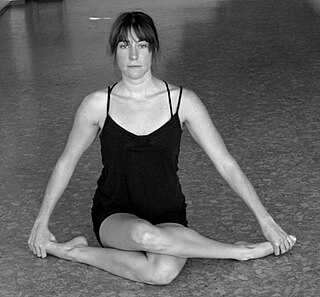
Yin Yoga is slow-paced style of yoga as exercise, incorporating principles of traditional Chinese medicine, with asanas (postures) that are held for longer periods of time than in other styles. Advanced practitioners may stay in one asana for five minutes or more. The sequences of postures are meant to stimulate the channels of the subtle body known as meridians in Chinese medicine and as nadis in Hatha yoga.
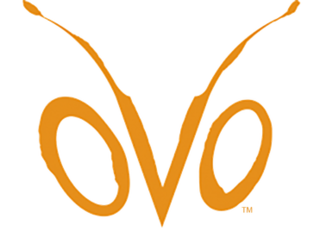
Ovo is a touring circus production by Cirque du Soleil that premiered in Montréal, Canada in 2009. Ovo's creator and director, Deborah Colker, took inspiration from the world of insects. The idea for Ovo was not to be about the acts, nor dancing, nor insects, but about movement. The movement of life permeates the entire show, with creatures flying, leaping, bounding, and crawling. Composer Berna Ceppas brought additional life to Ovo with a score inspired by the music of Brazil. Ovo means "egg" in Portuguese and represents the underlying thread of the show. Graphically, inside the logo of Ovo, is an insect. The two O's represent the eyes and the V forms the nose and antennas.
Axl Osborne is an acrobatic gymnast. He currently competes as the base in a mixed pair with his partner Tiffani Williams. With partner Tiffani Williams, Osbourne came 2nd at the 2016 Acrobatic Gymnastics World Championships. He previously competed as the base in a Level 9 mixed pair with his partner, acrobatic gymnast Lydia Webb.
Michael Rodrigues is a retired elite acrobatic gymnast who now performs in the Cirque du Soleil show Viva ELVIS in Las Vegas, Nevada, along with his former mixed-pairs partner, retired elite acrobatic gymnast Kristin Allen.
Marie Annonson is a retired elite acrobatic gymnast who currently owns the acrobatic gymnastics facility West Coast Training Center (WCTC) in Livermore, California.
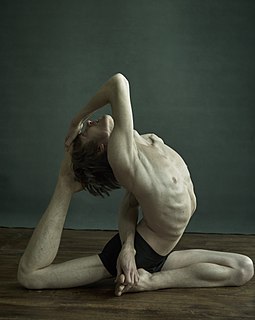
Eka Pada Rajakapotasana, Rajakapotasana, or [One-legged] King Pigeon Pose is a seated back-bending asana in modern yoga as exercise. The Yin Yoga form of the asana is named Swan Pose, while the Aerial yoga variant, supported in a hammock, is Flying Pigeon Pose. The pose is described in the 20th century by two of Krishnamacharya's pupils, Pattabhi Jois and B. K. S. Iyengar. It is one of the yoga poses often used in advertising to convey desired qualities such as flexibility and grace.

Kiley Boynton is an American female acrobatic gymnast. With Ryan Ward, she was awarded the bronze medal in the 2014 Acrobatic Gymnastics World Championships.
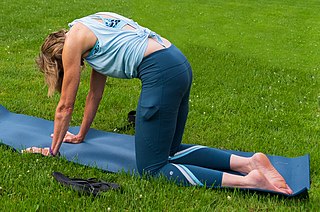
Bidalasana or Marjariasana, both meaning Cat Pose in Sanskrit, is a kneeling asana in modern yoga as exercise. A variant with one leg held up is Vyaghrasana, Tiger Pose; a similar variant with one leg held straight out is Chakravakasana, Sunbird Pose. A variant with the back lowered is Bitilasana, Cow Pose; this is often used as the counter-posture, and a widely used exercise is to alternate between Cat and Cow Poses repeatedly.

Parighasana or Gate Pose is a kneeling asana in modern yoga as exercise.
Hand to hand acrobatics is a type of performance in which an acrobatic base and flyer balance on top of each other in either a gymnastic or acrobatic medium. It combines strength, agility, flexibility, and balance. For it to be considered hand to hand acrobatics, the top performer (flyer) must be making physical contact only with the base's hands, with the flyer's hands keeping them balanced. Positions the top can perform in this style of acrobatics are straddles, handstands, pikes, press to handstand, one arm handstands, planches, flags, and many others. Hand to hand acrobatics can also include dynamic catches and throws that either begin with a throw from a hand to hand position or end in a catch in the hand to hand position.
Supta Padangusthasana, Reclining Hand to Big Toe pose, or Supine Hand to Toe pose is a reclining asana in modern yoga as exercise.

Yoga as exercise is a physical activity consisting mainly of postures, often connected by flowing sequences, sometimes accompanied by breathing exercises, and frequently ending with relaxation lying down or meditation. Yoga in this form has become familiar across the world, especially in America and Europe. It is derived from medieval Haṭha yoga, which made use of similar postures, but it is generally simply called "yoga". Academics have given yoga as exercise a variety of names, including modern postural yoga and transnational anglophone yoga.

The science of yoga is the scientific basis of modern yoga as exercise in human sciences such as anatomy, physiology, and psychology. Yoga's effects are to some extent shared with other forms of exercise, though it differs in the amount of stretching involved, and because of its frequent use of long holds and relaxation, in its ability to reduce stress. Yoga is here treated separately from meditation, which has effects of its own, though yoga and meditation are combined in some schools of yoga.






